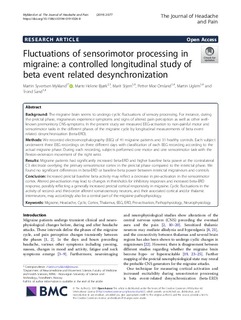| dc.contributor.author | Mykland, Martin Syvertsen | |
| dc.contributor.author | Bjørk, Marte-Helene | |
| dc.contributor.author | Stjern, Marit | |
| dc.contributor.author | Omland, Petter Moe | |
| dc.contributor.author | Uglem, Martin | |
| dc.contributor.author | Sand, Trond | |
| dc.date.accessioned | 2019-12-16T12:58:58Z | |
| dc.date.available | 2019-12-16T12:58:58Z | |
| dc.date.created | 2019-09-04T17:15:17Z | |
| dc.date.issued | 2019 | |
| dc.identifier.citation | The Journal of Headache and Pain. 2019, 20:77 1-10. | nb_NO |
| dc.identifier.issn | 1129-2369 | |
| dc.identifier.uri | http://hdl.handle.net/11250/2633427 | |
| dc.description.abstract | Background
The migraine brain seems to undergo cyclic fluctuations of sensory processing. For instance, during the preictal phase, migraineurs experience symptoms and signs of altered pain perception as well as other well-known premonitory CNS-symptoms. In the present study we measured EEG-activation to non-painful motor and sensorimotor tasks in the different phases of the migraine cycle by longitudinal measurements of beta event related desynchronization (beta-ERD).
Methods
We recorded electroencephalography (EEG) of 41 migraine patients and 31 healthy controls. Each subject underwent three EEG recordings on three different days with classification of each EEG recording according to the actual migraine phase. During each recording, subjects performed one motor and one sensorimotor task with the flexion-extension movement of the right wrist.
Results
Migraine patients had significantly increased beta-ERD and higher baseline beta power at the contralateral C3 electrode overlying the primary sensorimotor cortex in the preictal phase compared to the interictal phase. We found no significant differences in beta-ERD or baseline beta power between interictal migraineurs and controls.
Conclusion
Increased preictal baseline beta activity may reflect a decrease in pre-activation in the sensorimotor cortex. Altered pre-activation may lead to changes in thresholds for inhibitory responses and increased beta-ERD response, possibly reflecting a generally increased preictal cortical responsivity in migraine. Cyclic fluctuations in the activity of second- and third-order afferent somatosensory neurons, and their associated cortical and/or thalamic interneurons, may accordingly also be a central part of the migraine pathophysiology. | nb_NO |
| dc.language.iso | eng | nb_NO |
| dc.publisher | BMC (part of Springer Nature) | nb_NO |
| dc.rights | Navngivelse 4.0 Internasjonal | * |
| dc.rights.uri | http://creativecommons.org/licenses/by/4.0/deed.no | * |
| dc.title | Fluctuations of sensorimotor processing in migraine: A controlled longitudinal study of beta event related desynchronization | nb_NO |
| dc.type | Journal article | nb_NO |
| dc.type | Peer reviewed | nb_NO |
| dc.description.version | publishedVersion | nb_NO |
| dc.source.pagenumber | 1-10 | nb_NO |
| dc.source.volume | 20:77 | nb_NO |
| dc.source.journal | The Journal of Headache and Pain | nb_NO |
| dc.identifier.doi | 10.1186/s10194-019-1026-8 | |
| dc.identifier.cristin | 1721636 | |
| dc.description.localcode | © The Author(s). 2019 Open Access This article is distributed under the terms of the Creative Commons Attribution 4.0 International License (http://creativecommons.org/licenses/by/4.0/), which permits unrestricted use, distribution, and reproduction in any medium, provided you give appropriate credit to the original author(s) and the source, provide a link to the Creative Commons license, and indicate if changes were made. | nb_NO |
| cristin.unitcode | 194,65,30,0 | |
| cristin.unitcode | 1920,16,0,0 | |
| cristin.unitname | Institutt for nevromedisin og bevegelsesvitenskap | |
| cristin.unitname | Nevroklinikken | |
| cristin.ispublished | true | |
| cristin.fulltext | original | |
| cristin.qualitycode | 1 | |

